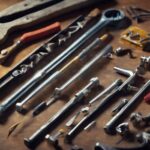- 7 Top Flite Golf Clubs XL for Improved Performance - September 28, 2024
- Top Flite Golf Clubs: Top 5 Reasons to Choose Them - September 28, 2024
- Top 3 Golf Club Fitters for a Perfect Swing - September 28, 2024
You hold the key to a precise golf swing in the hosel, a critical component that securely connects the shaft to the clubhead, governing overall club performance, weight distribution, and ultimately, shot trajectory and control. As you master your technique, you'll realize the hosel's significance in influencing shot accuracy, launch angles, and ball flight paths. Its design and customization options can make all the difference in your game, and understanding how to optimize its performance can help you tackle the green with confidence – so, take a closer look at this critical component to reveal your full golfing potential.
Key Takeaways
- The hosel is the socket connecting the shaft to the clubhead, ensuring a stable and consistent attachment that affects overall club performance and weight distribution.
- A well-fitted hosel enhances trajectory control and shot accuracy, leading to improved golf performance by promoting consistent shot trajectories and reducing shanking.
- The weight distribution of the hosel impacts the club's center of gravity, influencing shot trajectory and control during swings, and can be adjusted for customization.
- Hosel design and alignment affect spin, overall performance consistency, and the likelihood of shanking, making proper design and alignment critical for optimal performance.
Understanding the Hosel Component
As you explore the intricacies of a golf club, the hosel emerges as a critical component that deserves attention, serving as the socket that securely fastens the shaft to the clubhead.
The hosel is part of the club's anatomy that plays an essential role in connecting the shaft and clubhead, making it an integral aspect of overall club performance.
You'll find that the hosel's primary function is to provide a secure attachment point for the shaft, ensuring a consistent and stable connection.
This connection, in turn, affects the club's overall weight distribution, which can impact your shot trajectory and control.
Understanding the hosel's role in this process allows you to appreciate its significance in your golf game.
Club Performance and Weight Distribution
When you consider the intricate relationship between the hosel and club performance, it becomes clear that the hosel's weight distribution plays a significant role in determining the club's center of gravity, ultimately affecting the type of shots you can play.
Slight variations in hosel weight can make a big difference, promoting either a draw or a fade, depending on your swing style. Adjustable hosels in modern drivers allow you to fine-tune the loft and face angle, optimizing club performance based on your individual swing characteristics.
The hosel's design and position also impact the balance and stability of the club during swings, contributing to consistent shot direction. A well-fitted hosel can enhance your ability to control the trajectory and spin of the ball, improving overall accuracy and distance.
Hosel's Impact on Ball Trajectory
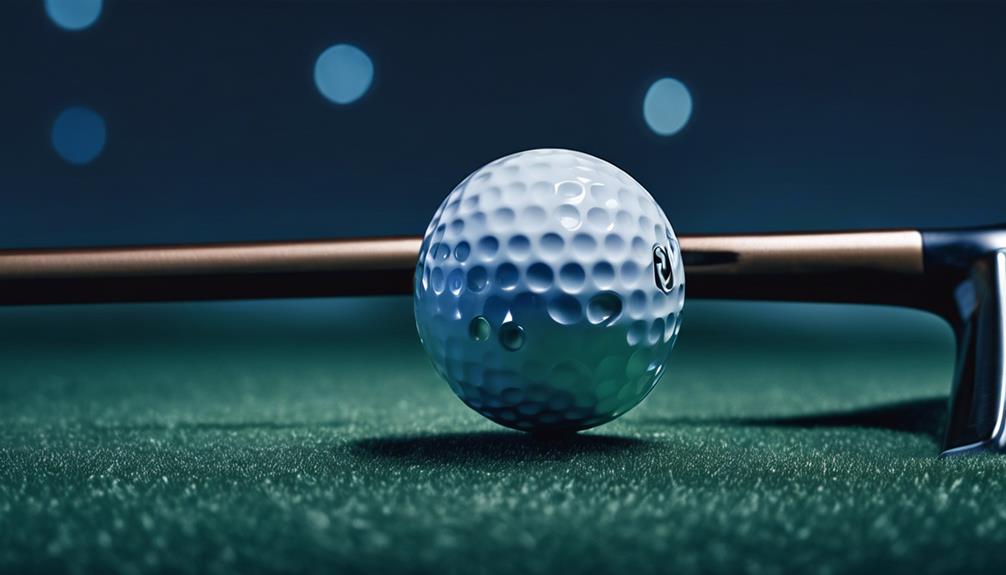
As you examine the hosel's impact on ball trajectory, you'll notice that adjusting the hosel angle can greatly alter the ball's flight path.
By fine-tuning the hosel, you can optimize face alignment, resulting in a more consistent and accurate shot.
Hosel Angle Adjustment
By tweaking the hosel angle, you can greatly alter the trajectory and direction of your ball flight, giving you precise control over your shot shape and overall performance. This adjustment allows you to change the loft and lie angle of the club, considerably impacting the trajectory and direction of the ball.
By fine-tuning your equipment, you can promote a draw or fade, which can help manage shot shapes based on your swing mechanics. Modern drivers often feature adjustable hosels, enabling you to customize your clubs quickly to fit different course conditions or personal preferences.
A change in hosel angle can influence the center of gravity of the clubhead, affecting launch conditions, spin rates, and overall ball flight. Proper hosel adjustment can lead to improved accuracy and distance, as it allows you to achieve ideal launch angles tailored to your unique swing characteristics.
Face Alignment Impact
You've optimized your hosel angle to tailor your shot shape and performance, but now it's time to focus on how the hosel's design and alignment impact the face angle of the club, directly affecting the initial launch direction of the ball.
A misaligned hosel can lead to inconsistent face angles at impact, resulting in unpredictable shot trajectories and increased likelihood of shanking.
Here are four key ways the hosel's design and alignment influence your ball flight:
- Face Angle Consistency: A well-aligned hosel guarantees consistent face angles, promoting predictable shot trajectories and reducing the likelihood of shanking.
- Loft and Lie Adjustment: Adjustable hosels allow you to fine-tune ball trajectory by modifying the loft and lie angle, catering to your individual swing characteristics.
- Center of Gravity Shift: The weight and shape of the hosel can subtly alter the center of gravity, influencing spin rate and overall ball flight stability.
The Dreaded Shank Shot Explained
When the hosel of your golf club makes contact with the ball instead of the clubface, a shank shot is born, releasing a wildly unpredictable trajectory that can leave even the most seasoned golfers bewildered.
You've probably experienced the frustration of watching your ball veer sharply off target, often to the right for right-handed golfers and to the left for left-handed golfers.
Shanking is considered one of the most undesirable outcomes in golf, leading to embarrassment and frustration for players. Many golfers avoid using the term 'shank' due to superstition, instead opting for euphemisms like 'hoseling' or 'hosel rocket.'
However, understanding the root cause of shanking is essential to preventing it. Misalignment in your swing and poor ball positioning near the hosel can contribute to shanking.
To avoid this dreaded shot, focus on maintaining proper swing mechanics and ball placement. By doing so, you can reduce the likelihood of hoseling and guarantee a more consistent and controlled game.
Golf Club Construction and Assembly
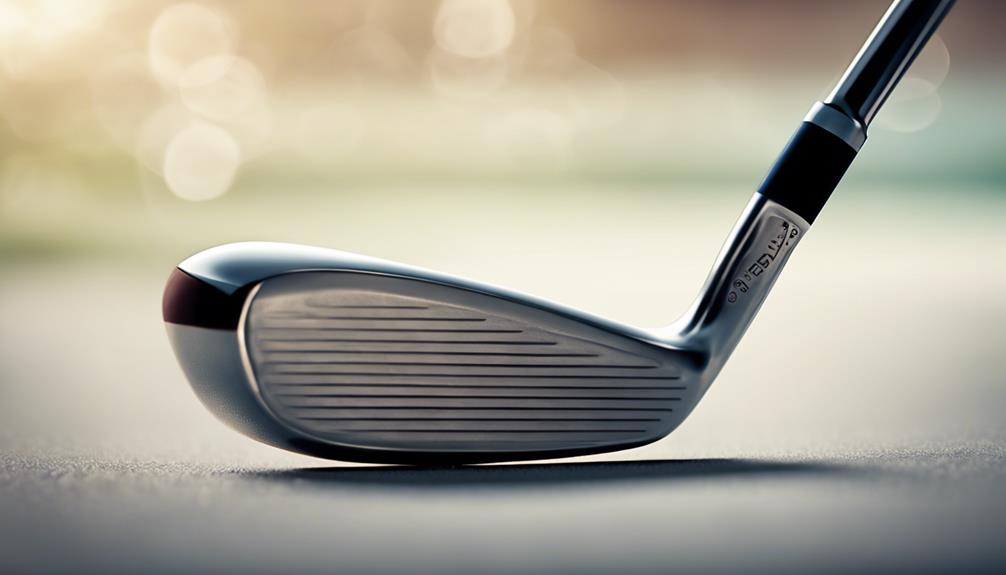
As you explore golf club construction and assembly, you'll focus on three critical points: the hosel connection point, shaft and clubhead alignment, and epoxy and ferrule assembly.
You'll learn how these components work together to create a solid bond between the shaft and clubhead.
Hosel Connection Point
During the assembly of a golf club, the hosel connection point is meticulously crafted to guarantee a secure and precise bond between the shaft and clubhead, ultimately influencing the overall performance of the club. This essential connection affects the club's swing dynamics and overall performance.
When you examine the hosel connection point, you'll notice that it's typically covered with epoxy and topped with a ferrule after assembly, making it an integral but often hidden part of the golf club's construction.
Here are some key aspects of the hosel connection point to reflect on:
- Weight and design impact: The hosel's weight and design affect the center of gravity, which can alter shot types, such as promoting draws or fades.
- Adjustability: Modern drivers often feature adjustable hosels, allowing golfers to customize loft and face angle to suit their playing style and optimize performance.
- Quality construction is key: Defects in the hosel can lead to issues like clubhead separation or compromised performance, highlighting the significance of quality construction.
Shaft and Clubhead Alignment
Proper alignment of the shaft within the hosel is critical, as it directly affects the overall stability and balance of the club, influencing your swing dynamics and shot accuracy.
When you're assembling a golf club, precise hoseling is essential to guarantee the shaft fits snugly into the hosel, allowing for ideal alignment. A misaligned shaft can lead to inconsistent shot patterns and poor performance.
The hosel's design plays a significant role in achieving proper alignment. Adjustable hosels, for instance, enable you to customize the shaft angle according to your swing style and preferences. This flexibility is particularly useful for golfers who require a specific setup to enhance their game.
Furthermore, the weight distribution within the hosel impacts the center of gravity, further affecting the alignment and overall performance of the club. By carefully considering these factors during assembly, you can guarantee your golf club is precisely aligned, resulting in improved stability, balance, and accuracy.
Epoxy and Ferrule Assembly
You secure the hosel of your golf club by applying a specially formulated epoxy that bonds the shaft to the clubhead, guaranteeing stability and strength during swings. This vital step in golf club construction and assembly is essential for peak performance.
After the shaft is inserted into the hosel and epoxy is applied, a ferrule, typically made of plastic or rubber, is placed at the top of the hosel for a finished look and to prevent moisture intrusion.
Here are the key considerations for epoxy and ferrule assembly:
- Epoxy formulation: The epoxy used in hosel assembly is specifically designed to withstand high stresses and impact forces encountered during gameplay.
- Ferrule placement: The ferrule is carefully positioned to guarantee a secure fit and prevent moisture from entering the hosel.
- Curing time: Proper curing time for epoxy is essential, requiring at least 24 hours to achieve full strength before the club is put into use.
The Role of Epoxy and Ferrule
In the assembly of a golf club, epoxy and ferrule play vital roles in guaranteeing the stability and performance of the hosel. Epoxy securely bonds the shaft to the hosel, while the ferrule provides a polished appearance and protects the joint.
When you're hoseling, the epoxy's strong bond is critical for delivering consistent shots and preventing issues like clubhead separation. If the epoxy isn't applied correctly, the shaft can loosen over time, greatly affecting shot accuracy and overall club performance.
The ferrule's decorative cover enhances the club's appearance and helps protect the epoxy joint from damage. As a golfer, it's important to regularly inspect the ferrule for signs of cracking or damage, which may indicate a need to check the epoxy's condition and the stability of the hosel connection.
Hosel Types and Putting Styles
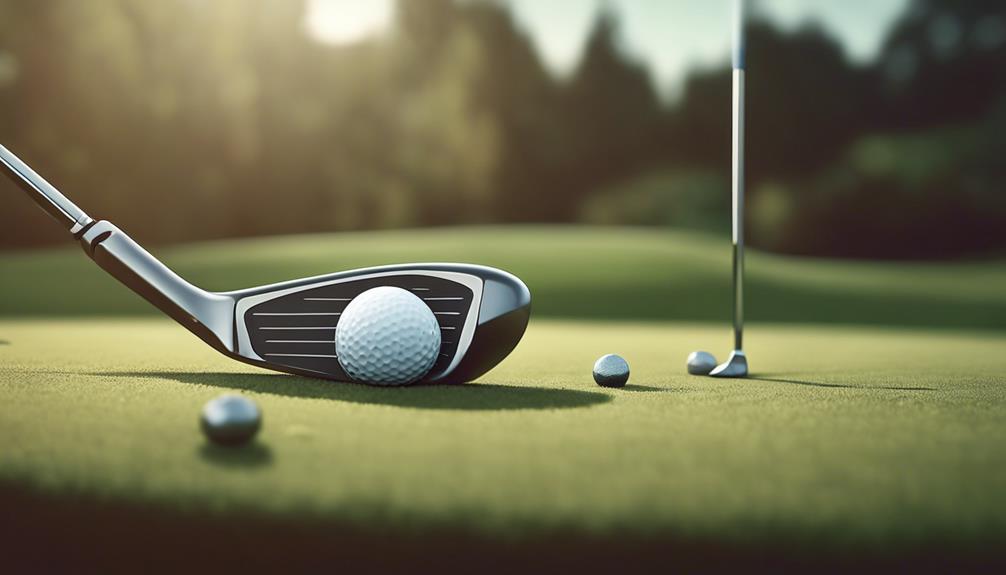
As you fine-tune your golf game, understanding the various hosel types and their corresponding putting styles becomes essential in optimizing your performance on the green. The type of hosel you choose can greatly affect your putting accuracy and overall game.
Here are four key hosel types to evaluate, each suited to a specific putting style:
- Short Hosel: Ideal for arc-shaped putting strokes, allowing for a more natural swing path.
- Plumber Neck Hosel: Versatile and suitable for combination strokes, providing a balanced feel during the putt.
- Center Shaft Hosel: Ideal for golfers who use a straight back and through stroke, promoting better alignment and accuracy.
Common Hosel-Related Issues in Golf
Shanking, a shot that strikes the hosel instead of the clubface, is a common and frustrating issue that golfers of all levels encounter, often resulting in unpredictable shot trajectories that veer sharply off target. When you shank a shot, it can be devastating, leading to a loss of confidence and a higher score. But what causes shanking, and how can you overcome it?
| Issue | Description | Impact on Game |
|---|---|---|
| Shanking | Ball strikes hosel instead of clubface | Unpredictable shot trajectories, loss of confidence |
| Improper Hosel Design | Hosel design affects swing mechanics | Inconsistent shots, poor alignment |
| Adjustable Hosel Issues | Improperly set adjustable hosels | Inconsistent shot performance, frustration |
| Hosel Wear/Defects | Manufacturing flaws or wear on hosel | Compromised club integrity, performance issues |
To avoid hoseling, it's crucial to inspect your clubs regularly for signs of wear or defects. Additionally, focus on proper swing mechanics and alignment to reduce the likelihood of shanking. By being aware of these common issues, you can take steps to master your game and avoid the frustration of hoseling.
Importance of Hosel in Club Fitting
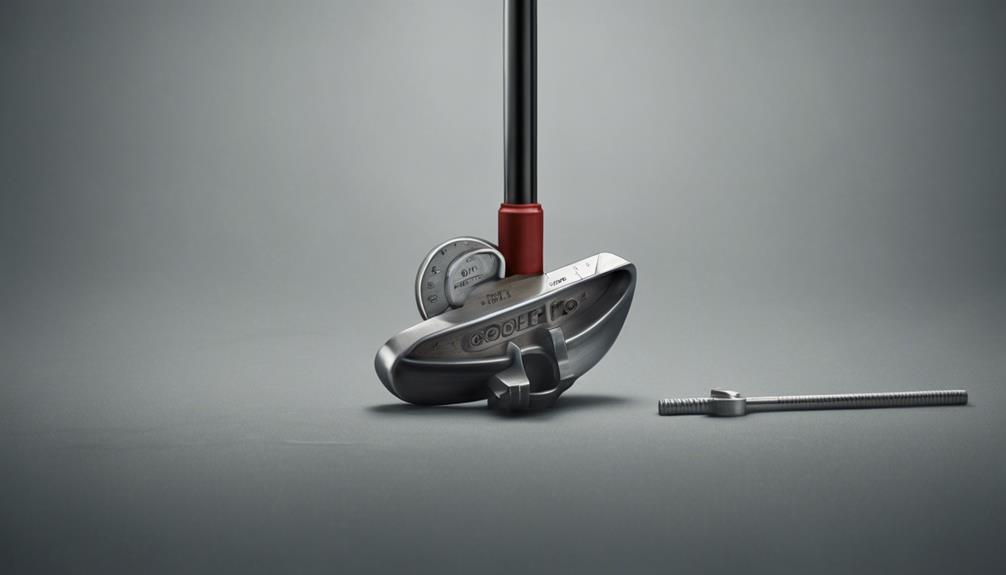
When you're getting fitted for a golf club, you'll want to take into account the hosel's customization options to guarantee it suits your unique swing style.
By understanding the different hosel fit options, you can optimize your club's performance to match your putting stroke, whether it's arc-shaped or straight back and through.
Hosel Customization Options
Your ability to tailor the hosel of your golf club to your unique swing characteristics is essential, as it directly impacts the performance of your equipment. Hosel customization options allow you to fine-tune your clubs to optimize their performance based on your individual swing style.
Here are four key benefits of hosel customization:
- Adjustable loft, lie, and face angle: Customize your club's settings to suit your swing, ensuring the perfect ball flight pattern.
- Improved shot trajectory and spin: Proper hosel customization can greatly affect shot trajectory and spin, leading to better accuracy and control.
- Better weight distribution and center of gravity: Custom hosel fittings can optimize weight distribution, influencing how the club interacts with the ball at impact.
Hosel Fit for Style
By understanding the importance of hosel fit in club fitting, you can release the full potential of your golf clubs and optimize their performance to match your unique swing style. A well-fitting hosel guarantees that the clubhead is properly aligned with the shaft, resulting in improved shot accuracy and consistency.
| Hosel Type | Characteristic | Suitable for |
|---|---|---|
| Short Hosel | Compact design, more forgiveness | Arc-shaped putting stroke |
| Plumber Neck Hosel | Increased stability, more control | Combination stroke |
| Adjustable Hosel | Customizable face angle, loft, and lie | Golfers with varying swing styles |
| Hoseling Hosel | Unique weight distribution, optimized CG | Draw or fade shots |
When selecting a hosel, consider your swing style and preferences. Adjustable hosels offer flexibility, while specific designs cater to distinct playing styles. Proper hosel selection can greatly impact your game, as it influences release patterns and overall balance in the swing. By understanding hosel characteristics, you can optimize the center of gravity, leading to more precise shots and improved overall performance.
Customization Options for Golfers
With modern golf clubs offering adjustable hosels, you can fine-tune loft, lie angle, and face angle to precisely match your swing and playing style.
This level of customization is a game-changer, allowing you to optimize your clubs for better accuracy and distance.
Here are some ways you can customize your hosels:
- Adjustable weight: The weight of the hosel can be altered during the manufacturing process to create different center of gravity configurations, influencing shot types such as draws or fades.
- Custom fitting options: Hosels can be tailored to fit your unique swing mechanics, greatly improving accuracy and distance.
- Hosel design selection: Specific hosel designs, like the plumber neck or short hosel, can be selected based on individual putting styles to enhance balance and performance on the greens.
Frequently Asked Questions
What Is Hosel in Golf Club?
You're likely curious about the hosel in your golf club, which refers to the socket where the shaft is inserted, influencing weight distribution and center of gravity through its design, affecting shot types and performance.
Where Is the Hosel of the Club?
You're getting down to the nitty-gritty, and the hosel's location is key. At the clubhead's neck, the shaft is inserted, and the hosel design takes center stage, influencing weight distribution and balance in a subtle yet essential way.
Why Am I Hitting off the Hosel?
You're hitting off the hosel because your swing path is misaligned, causing Hosel Slices that send the ball sharply to the right. Fix your outside-in swing and incorrect grip to center the ball and eliminate hosel contact.
How Do You Adjust the Hosel on a Golf Club?
"Fine-tune your swing with a hassle-free hosel adjustment! You'll easily customize your club's loft and face angle by loosening the screw system with a wrench, then rotating or repositioning the shaft to your desired specs."
Conclusion
As you walk off the course, club in hand, remember that the humble hosel is the unsung hero of your golf game.
Like a trusty steed from the medieval era, it carries the weight of your swing, influencing trajectory and performance.
Don't neglect this vital component – a well-fitted hosel can be the difference between victory and defeat.
So, take control of your game and master the hosel, for in its curves lies the key to golfing greatness.


